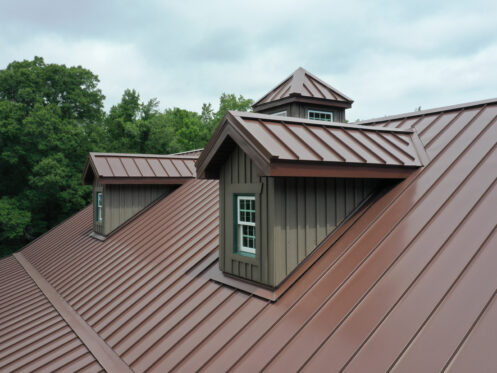You are looking at replacing your roof; however, you are not sure which type of roofing material is the best choice. Asphalt shingles remain the most popular choice for residential roofs, in part because they’re almost always the cheapest material to install. Metal roofing can also be an excellent option. Unfortunately, many people don’t even consider it simply because they believe certain things about metal roofing that just aren’t true.
Myth #1: Metal Roofs Are Noisy
One concern many people have about metal roofing is that they think it will make their house quite noisy at times, such as from things like rain, hail and falling acorns hitting the roof. The truth is that you won’t be able to hear these types of sounds inside your house any more with a metal roof than you do with shingles or other materials. The sound of something like hailstones hitting a metal roof can be slightly louder if you’re standing outside. Nonetheless, the wooden sheets under the metal and the insulation in the attic act as dampeners that minimize the noise you can hear inside.
Myth #2: Metal Roofing Makes a Home Less Energy Efficient
Another concern many people have is that a metal roof will absorb much more heat, causing the house to get overly hot in the summer and forcing the AC system to do far more work. Similarly, some people also believe that metal roofing will make a house colder in the winter and increase the amount of work the heating system has to do. The truth is that a metal roof actually makes a home more energy efficient and works better at preventing these issues compared to asphalt shingles. Asphalt shingles absorb a huge amount of heat from the sun whereas metal roofing reflects sunlight far better and doesn’t get nearly as hot. This is especially true if you opt for a lighter color instead of a dark color.
Myth #3: Metal Roofing Rusts or Gets Damaged Easily
Most metal roofing is made of steel, stainless steel and aluminum. While stainless steel and aluminum don’t rust, many people are concerned that steel roof sheets will rust quite quickly. The truth is that there’s very little chance of any type of metal roofing rusting, even steel. That’s because the sheets have a protective coating of zinc or a zinc-aluminum alloy that’s specifically meant to ensure the roof doesn’t rust. The only time you really need to worry about a metal roof rusting is when it gets much older or if the sheets get damaged to the point where the underlying steel is exposed.
In general, damage is a much smaller concern with metal roofing. Asphalt shingles can easily get damaged by hail, flying debris and strong winds, which can then easily result in the roof leaking. Metal roofing, on the other hand, is far stronger and more durable. That’s why it’s considered the safest and best option for areas prone to hurricanes or severe thunderstorms. The fact that metal roofing is far less likely to suffer storm damage is also why many homeowners insurance companies offer discounted rates for homes with metal roofs.
Myth #4: Metal Roofing Is Overly Heavy
Another worry when switching to metal roofing is that you may need to have your roof reinforced to support the added weight of the metal sheets, further increasing the cost of the roof replacement. While some types of metal roofing, such as heavier gauge steel, are a bit heavier, other types like aluminum can actually be lighter than asphalt shingles. Even with the slightly heavier options, there’s very little chance of your roof not being strong enough to support the weight of the metal sheets, as long as it was built properly and its underlying structure is still in good shape.
Myth #5: Metal Roofs Are Unattractive
Many people tend to associate metal roofing mostly with commercial buildings, as they believe all types of metal roofing are unattractive or give the building a more industrial look. This is true for some types of metal roofs, especially ones where all of the screws and fasteners are exposed. Nonetheless, there are various metal roofing options that are quite handsome and stylish and will actually add to the aesthetic appeal of the home instead of detracting from it.
Standing-seam metal roofing is becoming an especially popular option for homes. All of the fasteners used in this type of metal roofing system are hidden, ensuring the roof has a sleek, streamlined appearance. You also have almost as many options in terms of color and style with metal roofing as you do with shingles.
Myth #6: A Metal Roof Is a Lightning Magnet
The fact that metal is highly conductive to electricity leads many people to believe that installing a metal roof greatly increases the chances of the home getting struck by lightning. The truth of the matter is that the chances of a lightning strike are essentially the same no matter what type of roof you have.
Lightning always takes the shortest, least resistance path that allows the electricity to discharge into the ground. Any metal object offers a very low resistance path for the electricity to discharge due to how conductive the metal is, but that still doesn’t mean a metal roof acts like a magnet that attracts lightning. The key is that the lightning also tries to find the shortest path where it has to travel the least amount of distance for the electricity to discharge. That’s why it’s so common for lightning to strike taller trees, as the tree provides it a short path to the ground. Similarly, if your neighbor’s house is taller than yours, lightning will be more likely to strike their house than yours regardless of the type of roof either house has.
Not only does metal roofing not attract lightning, but it also makes the roof safer should it get struck by lightning. The fact that metal roofing is highly conductive means the electricity gets quickly discharged and then disperses across the entire roof. If lightning strikes a non-conductive material like asphalt shingles, the electricity all discharges right at the point of the strike. The fact that shingles aren’t nearly as conductive also means the electricity encounters much more resistance. This increased resistance results in an extreme amount of heat being released, creating a significant risk of the roof catching fire. The risk of the roof catching fire is also much higher simply because shingles are combustible whereas metal roofing is non-flammable.
Myth #7: Metal Roofing Is Overly Expensive
When replacing your roof, price is almost always going to be one of your main concerns. It’s true that installing asphalt shingles typically costs less compared to metal roofing. However, the lower cost is somewhat of a trade-off since a shingle roof is never going to last as long as a properly maintained metal roof. Even though some asphalt shingles are rated to last for 40 or 50 years, the truth is that you’re always lucky if you get more than 25-30 years of life out of a shingle roof. With metal roofing, you’re usually looking at a minimum of 40 to 50 years before you next need to replace your roof. This increased life expectancy means that a metal roof is typically a more cost-effective option in the long term. The fact that metal roofing is less likely to get damaged also means there’s less of a chance of you needing to pay for roof repairs.
Reach Out to the Pros
Red Bird Roofing is the company to look to when you need an honest, dependable roofing contractor in Carmel, Lafayette or the Greater Indianapolis area. We specialize in roof installation and repairs and work with a variety of roofing materials, including shingles, metal and slate. To schedule a consultation and get help deciding which roofing option is right for your home, contact us today.






